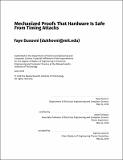Mechanized proofs that hardware is safe from timing attacks
Author(s)
Duxovni, Faye(Faye Samara)
Download1108621497-MIT.pdf (144.5Kb)
Other Contributors
Massachusetts Institute of Technology. Department of Electrical Engineering and Computer Science.
Advisor
Adam Chlipala.
Terms of use
Metadata
Show full item recordAbstract
A recurring problem in cryptography engineering is the potential for secret data to be leaked through aspects of software and hardware that are orthogonal to functional correctness. In particular, much effort is put into writing cryptography code whose timing behavior - how many CPU clock cycles it takes to complete a given cryptographic operation - is independent of any secret inputs to that operation. This is a difficult problem because it depends not only on the code itself, but also on various optimizations such as branch prediction and memory caching implemented by the underlying hardware the program runs on. We make use of Kami, a domain-specific language for describing and formally verifying hardware modules, to build a system for constructing machine-checked proofs that a given piece of code running on a given RISC-V CPU design will not leak secret inputs through timing behavior. Our system allows software and hardware to be analyzed and verified independently, and we prove that any combination of software and hardware that meet our validation criteria will be safe from timing-based side channels. We demonstrate an example of validating a real cryptographic program and a concrete RISC-V CPU using our system, illustrating the applicability of our tools and laying the groundwork for validating more complex programs and CPUs.
Description
This electronic version was submitted by the student author. The certified thesis is available in the Institute Archives and Special Collections. Thesis: M. Eng., Massachusetts Institute of Technology, Department of Electrical Engineering and Computer Science, 2018 Cataloged from student-submitted PDF version of thesis. Includes bibliographical references (pages 47-48).
Date issued
2018Department
Massachusetts Institute of Technology. Department of Electrical Engineering and Computer SciencePublisher
Massachusetts Institute of Technology
Keywords
Electrical Engineering and Computer Science.